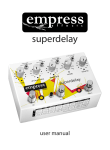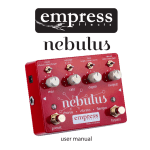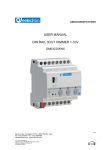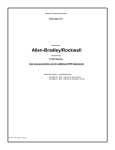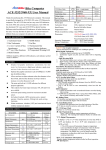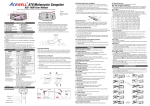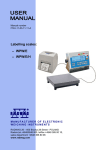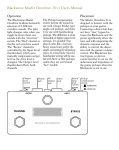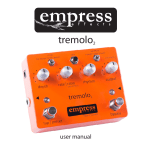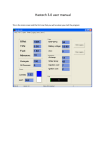Download User Manual
Transcript
buffer & buffer+ user manual Introduction The Empress buffer and buffer+ were designed to be the complete I/O interface for the pedal board, while maintaining the highest fidelity to your guitar's signal. Signal loss due to long, un-buffered cable runs is an issue that has plagued guitar players for decades. The primary goal of the buffer is to eliminate this signal loss, ensuing that your tone is unchanged by your cables. Additionally, all the connectivity of your pedal board is consolidated to make set up quick and easy. In the buffer+, extra features such as selectable boost and noise filtering ensure maximum control of your tone. Boost mode: The buffer+ can provide up to 30dB of clean boost . To activate the boost, simply press the boost stomp switch and use the boost knob to set the level. A blue led will light to indicate that you are in boost mode. Press the stomp switch again to turn off the boost. Silent Tuning mode: The tuner out can be used for silent tuning by holding the boost stomp switch down for about 1 second. This will mute the signal being sent from the amp out. A red LED will light to indicate that you are in silent tuning mode. Press the boost stomp switch again to exit silent tuning mode. The buffer+ will return to whichever boost state (on or off) it was in, prior to entering silent tuning mode. Controls at power: + tip 2.1mm jack. 42 tuner: output to tuner or use as a second output for a stereo setup, DI for recording or for a key signal for something that likes a clean signal such as a gate or compressor. pedalboard t a Glance 9V DC negative 2mA or greater. guitar in: plug your guitar in here. The high impedance input will not load down your guitars pickups and will result in the full range of your tone to pass through. amp out: This buffered output can drive a long cable run without signal loss. Controls at input: boost or cut the input of the buffer+ by 3dB. Use this to balance the output of different guitars or to increase/decrease the output to the pedals in the loop. tuner: output to tuner or use as a second output for a stereo setup, DI for recording or for a key signal for something that likes a clean signal such as a gate or compressor. pedalboard boost stompswitch: press to engage the boost (amout of boost set by boost knob). Hold for 1 second to mute the output while tuning. power: + tip 2.1mm jack. 80 t a Glance 9V DC negative 0mA or greater. noise filter: use noise filter to reduce noise generated from pedals in the loop. boost: set how much volume boost is added when engaged by the boost switch. input loading: control how much load is placed on your pickups. fully clockwise will produce the cleanest sound with the most bandwidth. guitar in: plug your guitar in here. amp out: This buffered output can drive a long cable run without signal loss. Noise filter: The noise filter can help eliminate certain types of undesired noise from you signal path, especially white noise and hiss generated from digital pedals. The noise filter will reduce this noise on any pedal that is inside the loop. Note that, when using the noise filter with high gain pedals (eg distortion) in the loop, you might notice a change in the high frequency response. This is normal and can usually be corrected with some gentle EQ. Input: This switch allows you to boost or pad the input signal at the guitar in jack by +/- 3dB. This can be useful for matching levels from different instruments (ie. passive and active pickups, or single coil and humbucking guitars). It can also be used to push a hotter signal to your pedalboard resulting in a better signal to noise ratio. Set the switch to 0dB for unity gain. Input Loading: This knob allows you to vary the load seen by your guitar pickups at the guitar in. Turning the knob fully clockwise increases the load and allows the full frequency range of your guitar to pass through. As you turn the knob counter-clockwise you'll begin loading down your guitar, changing the response of the pickups and rolling off some high frequencies. Alternate Use The buffer and buffer+ can also be used to split the input signal to multiple outputs. The input signal is normally routed to the loop out and tuner out. When nothing is connected to the loop in jack, the input signal will also be routed to the amp out jack, essentially making the buffer a 1in 3out splitter. This could be useful to run multiple amps or to record a second dry signal when tracking for re-amping later. note: the grounds of each output are not isolated, and connecting to multiple sources could cause a ground loop. Lifting the audio ground (not the power ground) on one of the devices connected to the ouputs should solve ground loop issues. Specifications Input Impedance: Output Impedance: Freq. Response: SNR: Headroom: THD: Input Voltage: Required Current: Power Connector: Height: Length: Width: Weight: 10kΩ-1MΩ 510Ω 5Hz – 40kHz 105.3dB +9.4dBu 0.02% 9VDC 80 mA 2.1mm Barrel 1.25” 4.5” 2.5” 0.5 lbs Warranty Serial # ____________ Empress Effects products come with a two year warranty against failures resulting from defective parts and/or faulty workmanship. The warranty can be extended to 4 years for free by registering online at: www.empresseffects.com/register The warranty applies only to the original owner of the product. While a product is under warranty, Empress Effects will repair the product free of charge. We reserve the right to cancel the warranty should the product be tampered with, modified, damaged through misuse, or damaged through failure to follow the operating instructions. Empress Effects liability is limited only to repair and replacement of a defective product. Please contact Empress Effects before shipping a product to us.












